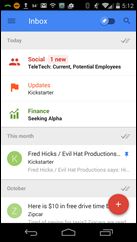 If you’ve heard about Google’s new “Inbox” system for reading GMail, you’re just about to have your chance to request an invitation. Between 6 p.m. and 7 p.m. Eastern (3 p.m. and 4 p.m. Pacific) today (starting just about 40 minutes from now), Google will send invitations to everyone who requests one. Just send an email to inbox@google.com between 6 and 7 and you’ll get your invitation by 8 p.m. (5 p.m. Pacific).
If you’ve heard about Google’s new “Inbox” system for reading GMail, you’re just about to have your chance to request an invitation. Between 6 p.m. and 7 p.m. Eastern (3 p.m. and 4 p.m. Pacific) today (starting just about 40 minutes from now), Google will send invitations to everyone who requests one. Just send an email to inbox@google.com between 6 and 7 and you’ll get your invitation by 8 p.m. (5 p.m. Pacific).
I requested an invitation the day it launched and got it the very next day. I’ve been using it since then, on my PC, tablet, and smartphone, and have definitely liked what I’ve seen. In some ways, it’s a simpler and more intuitive way to read mail than GMail’s basic interface, especially on a mobile device. But it’s also a considerable change to the way email works.
For the most part, you can try out Inbox without changing the way you read email in GMail if you want. Or you could continue using GMail on your computer but switch to Inbox on mobile. However, depending on how you read GMail now, there is one major change you might have to make, and that has to do with archiving your old email.
If you’re like me, you might not ever have archived anything since you started using GMail. What the “archive” is isn’t really all that well explained, and it makes it sound like you’re shoving the email somewhere out of sight where it’s hard to find or use. But that’s only half right. Until I started using Inbox, I didn’t realize that, while “archiving” does shove the email out of sight, you can still search its contents by default, or pull it up for browsing with one click. It doesn’t even change whether the email is marked read. It’s just a way to clear out your inbox so the only mail that shows up in it is new mail.
The reason this is important is that Inbox works on a paradigm that presents your email like a “to do” list. When you’re “done” with an email, you click the check mark to mark it “done” and it vanishes from your screen. It’s functionally the same as “archiving,” just by another name. (I suspect that Google made this change intentionally to try to get away from the scary, confusing nature of “archiving” emails so people would do it more.) The upshot is, if you keep your inbox full of thousands upon thousands of messages, you can click “done” until the cows come home and it’ll keep presenting you older and older messages.
So, if you’re planning to try out Inbox, the first thing you should do is archive all your emails. You can do with with a simple search formula, as shown on this page. Note that if you have a lot of email in your inbox (I had 66,000 messages), it will take GMail a few minutes to finish the task. Note that if you later decide you don’t like it, you can always go into “All Mail” where your archived messages go and use the same kind of trick to move them all back again later.
I would recommend going ahead and archiving your old email even if you don’t plan to use Inbox. It’s a lot nicer to have an almost-empty GMail rather than seeing the accusing stare of a five-digit unread messages number.
Using Inbox
What is using Inbox like? A lot simpler than using Gmail. The biggest difference is that, instead of having multiple tabs for things like your main inbox, social networking, and promotions, Inbox uses a system of expandable cards similar to Google Now. You see cards for each of your “bundles”—specific categories of email, like social, promotions, forums, and updates—that list who the senders are. Tap on a card and it expands to list the messages; tap on a message to read. You can mark individual messages or the entire bundle “done” using check marks to the right.
The interesting thing is, you can also “snooze” messages for later. If there’s something you can’t do anything about until you’re at home, or work, or the weekend, you can “snooze” it and it will disappear and not clutter up your inbox until then—though it will come back to remind you at the appointed time. For example, this morning I received a shipping notification on a package that will take a week or two to arrive. I snoozed it until next week, and it will pop up again on Monday and remind me to check the package’s progress then.
You can also pin messages, serving a similar purpose to marking them important in GMail. You can toggle a switch so that your mailbox only shows your pinned messages, useful for picking them out among those less important.
Inbox also hybridizes mail and calendar functions. If you’re inclined to use Google Now’s “Reminders”—for example, you might hit Google voice search and say “Remind me at 4:30 p.m. to buy milk and eggs on the way home”—you’ll get those reminders in your Inbox, too. And they can be snoozed or pinned just like regular email.
In addition to mobile versions for Android and iOS phones and tablets, there is also an Inbox web site that you can use, which looks rather similar to the one on your phone. It uses the same Material Design widgets, the same bundles, and so forth, and generally works in a very familiar way. The drawbacks are that it can’t show subject lines as long as traditional GMail, it doesn’t include the Google Talk plugin, and it doesn’t have a way (that I can find) to refresh your inbox. (You can refresh the mobile versions just by swiping down on the screen.)
Happily, apart from the necessity of archiving your backlog, Inbox and GMail are perfectly compatible. You can keep using GMail on the web while using Inbox on mobile devices, or vice versa.
One minor problem I have with Inbox is that there’s apparently no way to set it to send outgoing emails with a different address in the From: field. (I use my eyrie.org address for receiving email, but read it via Gmail.) I hope they fix that soon.
Anyway, if you’re interested, don’t forget to send your email after the top of the hour. If you missed it, you can still request an invitation; it just might take a while to show up. Or you might be able to get an invitation from a friend or acquaintance; they’ll have plenty to hand out.
































Hi Chris, I got the new version of Gmail on my phone automatically and there seems to be one fairly big drawback. There is now no visible difference between read and unread email!
Since you didn’t mention this problem in your review I guess you didn’t experience it?
The inbox version sucks unless there’s a way to add more email accounts. Gmail and not Gmail accounts.